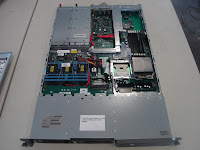In my last post I outlined the steps necessary to load an .img file so we could get a functional OS on the Orange Pi PC.
A fun project I wanted to try out was to start sending aircraft ADS-B data to an online service.
This post will outline what hardware you will need and how to load RTL-SDR drivers, Install ModeSMixer2 and ModeSDeco2 and configure the software to feed the ADSB Exchange.
I ended up using the following commands:
ModeSDeco2:
./modesdeco2 –gain 49.5 -–web 8000 –sbs10001 10001
ModeSMixer2:
./modesmixer2 –inConnect 127.0.0.1:10001 –outServer sbs10001:10002 –outConnect avr:feed.adsbexchange.com:30005
For more commands – visit the source site at: xdeco.org
Wednesday, November 11, 2015
Friday, October 23, 2015
Installing Linux .img files on the Orange Pi PC
I had to dig around for this information and I did a little trial and
error to figure it out but I got a working version of Linux on the $15
Orange Pi - PC.
The first place you need to look is: Orange Pi Forums - Thread on Installing .img files
He has good instructions but I am not the most proficient Linux user in the world, so I needed a little extra help. I hope this helps someone else like me that is not proficient at the command line.
I am going to assume you have a Linux computer with a GUI like Gnome or KDE, LXDE, Etc.
Step 1.
Create a folder on your PC where you can store some files that you will download. I just put my folder on the desktop. I created a folder called opi
Step 2.
Download any of the available distro images (xz archive) from the Mega or GoogleDrive sites Loboris has listed.
You have lots of options: Debian, Arch, OpenSuse, Ubuntu, Fedora, Etc. I downloaded
OrangePI_Lubuntu_Vivid.img.xzStep 3.
Download
scriptbin_kernel.tar.gz, it contains the latest Linux kernel (uImage) and script.bin.Step 4.
Navigate to the folder you created and unpack, unzip, uncompressed, extract or whatever you want to call it BOTH files you just downloaded. Most modern versions of Linux let you right click on a file and extract it. I used the Engrandpa archive manger that come with the Mate desktop but yours may be called Ark, File Roller, Etc.
Step 5.
Open a terminal program like Xterm so we can get to the command line. The first command we need to run is
df -h to see what devices are currently mounted. Step 6.
If your computer has a slot for SD cards, insert the card. If not, insert the card into an SD card reader, then connect the reader to your computer
Step 7.
Run
df -h again. The new device that has appeared is
your SD card. The left column gives the device name of your SD card; it
will be listed as something like /dev/mmcblk0p1 or /dev/sdd1. The last part (p1 or 1
respectively) is the partition number but you want to write to the
whole SD card, not just one partition. Therefore you need to remove that
part from the name (getting, for example, /dev/mmcblk0 or /dev/sdd)
as the device for the whole SD card. This will be important in step 10.Step 8.
Now that you've noted what the device name is, you need to unmount the SD card so that files can't be read or written to the SD card while you are copying over the SD image. Run
umount /dev/sdd1, replacing sdd1 with whatever your SD card's device name is (including the partition number).Step 9. - The hard part
In the terminal, write the image to the SD card with the command below, making sure you replace the input file
if= argument with the path to your .img file, and the /dev/sdd in the output file of=
argument with the right device name. This is very important, as you
will lose all data on the hard drive if you provide the wrong device
name. Make sure the device name is the name of the whole SD card as
described above, not just a partition of it; for example sdd, not sdds1 or sddp1; or mmcblk0, not mmcblk0p1. Now for the command:
sudo dd if=OrangePI_Lubuntu_Vivid.img of=/dev/sdd bs=1M oflag=direct
sudo dd if=/home/john/Desktop/opi/OrangePI_Lubuntu_Vivid.img of=/dev/mmcblk0 bs=1M oflag=direct
Run command
sync in the terminal, this will ensure the write cache is flushed and that it is safe to unmount your SD card. You can close the terminal program now.Step 11.
I used a graphical file manger for the rest of the steps. Open up your graphical file manager and then physically remove the SD card from the computer and then reinstall it in the SD slot. You should see the SD card appear in the graphical file manager. Right click it and mount the SD card. You should see two items now. One partition called BOOT and the other partition called Linux. If you do not see this you may want to remove the SD card and try again.
Step 12.
In the graphical file manger double click on the BOOT partition. When you do, you should see a bunch of files. We are only interested in two files: script.bin and ulmage. Rename both files. I renamed them script.bin.default and ulmage.default
Step 13.
Remember that folder you created on your computer at the beginning of this little project and downloaded the two files to which you extracted? Navigate to that folder.
Step 14.
Find the file uImage_OPI-2 or uImage_OPI-PLUS (depending on the type of Orange Pi you have ) and rename it to uImage (The Orange Pi-PC use uImage_OPI-2)
Step 15.
Determine the resolution and refresh rate of the monitor you will connect your Orange Pi to. You may also want to figure out how you will supply the video feed to the monitor. I am using a TV with a resolution of 1080p with a 60Hz refresh rate. I also wanted to use the HDMI cable.
Step 16.
In the folder you created on your PC, find a script.bin.OPI-XXXX file that best matches your version of Orange Pi and monitor setup. For my Orange Pi PC and the TV I was going to use as a monitor, the best file was script.bin.OPI-PC_1080p60_hdmi. After you find the best file rename it to script.bin
Step 17.
Copy the the two files you just renamed to ulmage and script.bin and paste them into the BOOT partition. Unmount and safely remove the SD card from your computer.
Step 18. Install the SD Card into the Orange Pi and boot into your new system! The username and password are: orangepi
Step 19.
Resize the Orange Pi partition to fit your SD Card size by using the following command in a terminal:
sudo fs_resize After running this command you will be prompted to reboot.Step 20.
After rebooting it is a good idea to update all system package with the package manger
Step 21.
Have Fun!
Monday, February 15, 2010
TLLTS Discussion About Virtulization
Linc over at The Linux Link Tech Show (TLLTS) had a very good conversation about Virtulization and VMWare last week. Look for episode 340.
Wednesday, October 7, 2009
Another Day Another DL
 I finally pulled the trigger and purchased my 4th HP DL360 Proliant Server for my brother-in-laws growing IT system. This new sever will be used as an email server running SME Server 7.4. I guess it is the nerd in me but I am always amazed at how much technology you can purchase for so little if you are willing to shop around.
I finally pulled the trigger and purchased my 4th HP DL360 Proliant Server for my brother-in-laws growing IT system. This new sever will be used as an email server running SME Server 7.4. I guess it is the nerd in me but I am always amazed at how much technology you can purchase for so little if you are willing to shop around.The latest server specs are:
HP DL360 G3
Dual Xeon 2.8 GHz processors
Dual 36GB Ultra 320 SCSI Drives
Dual Power Supplies
Dual 1 GB Ethernet
HP 5i on board RAID Controller
HP iLo management
2 GB of RAM
CD-ROM and Floppy Drive
On board Video and Legacy Ports
And how much for all of this technology? A hefty $99 USD on eBay. The last DL360 I pickup I was able to purchase for $51 USD!
What is truly funny is replacement rack rails end up cosing 40% of the total cost of the server!
Sunday, October 4, 2009
Vector Linux
 I have spent the last few weeks evaluating different distros I can use as an OS on my brother-in-law's administration terminal server. I tried a net install of Debian 5.0 but in the end it required way too much tweaking to get what I was after. Debian with LXDE was very speedy and would have done the job but for some reason I was really having difficulties making OpenSSH and VNC work in harmony. VNC is must because I must administer several applications that use a web interfaces.
I have spent the last few weeks evaluating different distros I can use as an OS on my brother-in-law's administration terminal server. I tried a net install of Debian 5.0 but in the end it required way too much tweaking to get what I was after. Debian with LXDE was very speedy and would have done the job but for some reason I was really having difficulties making OpenSSH and VNC work in harmony. VNC is must because I must administer several applications that use a web interfaces.I did a search on DistroWatch under the category of old computers and it come up with about 20 recommendations. The usual suspects came up; Puppy, DSL, Slitaz, Tiny-Core. The rest fell into two broad categories, the first being Ubuntu based distros using lightweight window managers. The second group were based on Slackware. I have a soft spot in my heart for Slackware. Wolvix was the first distro I could get my wireless card at the time (three years ago) working properly. Because of this Wolvix paved the way towards full time Linux usage breaking my Windows fix. I haven't looked back.
Absolute, AUSTRUMI, SaxenOS and Vector were the Slackware based distros that caught my eye. A quick review narrowed my interest to Absolute or Vector. I decided to install Vector on a 700mhz test machine with 512meg of RAM because they had just released their 6.0 Lite Version.
After the install I was greeted with a very usable system even on the 700mhz test rig. I was able to configure OpenSSH and VNC without any major issues. At boot, running JWM as the window managers, I was using only 50meg of RAM and CPU utilization was in single digits. I am very impressed with Vector so far!
Tuesday, September 15, 2009
I Like My Time
 I got my Webmin books and I started to review them. It dawned on me after a few days I was going to have to speed a lot of time setting up the various services in S*M*S. I think this would be a great learning experience but I just do not have the time so I am going with SME Server as my solution. I hope version 8 comes out soon but I have a feeling I will have to install the current stable version which is 7.4.
I got my Webmin books and I started to review them. It dawned on me after a few days I was going to have to speed a lot of time setting up the various services in S*M*S. I think this would be a great learning experience but I just do not have the time so I am going with SME Server as my solution. I hope version 8 comes out soon but I have a feeling I will have to install the current stable version which is 7.4.I have also started to looking for a distro that I can use on an administration server at my brother-in-laws practice. This a very old Penguin Computing server that has a 700MhZ processor with 512Mb of ram. I have been using Puppy Linux for a few months but I am looking for a lightweight distro that has a little better out of the box support for OpenSSH. I favor rolling release distros so it will be interesting if I can find something light enough to server my purpose. I could always and should install Arch Linux but I want to see if anything different is out there.
Friday, September 4, 2009
Learning Curve
 I finally found time to install S*M*S on the OptiPlex at work yesterday. It turned out to be a a relatively painless install. I fired up Firefox on another computer on the network and was able to pull the Webmin interface up. A quick test drive revealed a pretty zippy system even on this ancient OptiPlex that could serve as a boat anchor. It also revealed I am pretty rusty when it comes to Webmin. I have not used it actively for over 5 years so I started looking for some good books on using Webmin but it appears the most recent ones are around five years old. The good thing about five year old books is you can pick them up dirt cheap on Amazon. Two of the the best user rated Webmin books were only a few clicks and $18 bucks away. I should get them some time next week. If the books turn out to be too out of date I guess I can resort to printing out the 800+ page pdf webmin book or sections out of the offical Webmin Wiki.
I finally found time to install S*M*S on the OptiPlex at work yesterday. It turned out to be a a relatively painless install. I fired up Firefox on another computer on the network and was able to pull the Webmin interface up. A quick test drive revealed a pretty zippy system even on this ancient OptiPlex that could serve as a boat anchor. It also revealed I am pretty rusty when it comes to Webmin. I have not used it actively for over 5 years so I started looking for some good books on using Webmin but it appears the most recent ones are around five years old. The good thing about five year old books is you can pick them up dirt cheap on Amazon. Two of the the best user rated Webmin books were only a few clicks and $18 bucks away. I should get them some time next week. If the books turn out to be too out of date I guess I can resort to printing out the 800+ page pdf webmin book or sections out of the offical Webmin Wiki.The big question now is do I go with S*M*S and deal with the steep learning curve of relearning Webmin or should I just use SME Server to save time knowing it will do most of what my brother-in-law wants.
Subscribe to:
Comments (Atom)




